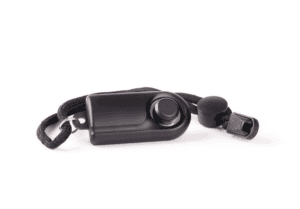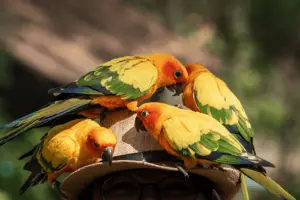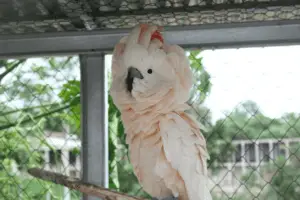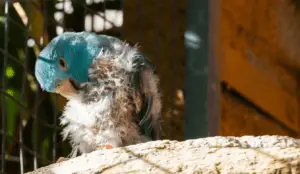You have finally adopted a parakeet and love spending time with your new pet as it’s making everyone in your home happy. But since it’s still a new pet, you’re still trying to figure out a perfect name for your bird. Unfortunately, you don’t know its gender since you got it as a gift or the breeder did not inform you of the sex of the bird.
Which begs the question, how can a pet owner determine the Parakeet’s sex?
After all, your bird needs the right name representing its female or male personality. And if contacting the breeder is not an option, you need to find another way. Luckily, determining the sex of any parakeet is relatively easy.
The simplest and most common method for determining your Parakeet’s sex is by examining the colors of the cere. Males have a royal blue cere while females come with pale blue, brown, or white. You can also listen to the number of noises it produces; males tend to be noisier than females.
Parakeets make exceptional pets; one of the best ways to socialize with them is by giving them a unique name. Remember, its name gives it an identity; therefore, you must determine its sex before picking a name.
So in this guide to parakeet sexing, we’ll show you how to determine the sex of your Parakeet, irrespective of its age. We’ll also show you the importance of determining the sex of a parakeet, so let’s dive right in.
How To Determine The Sex Of A Parakeet?
Generally, people love parakeets as pets, and the Australian budgerigar is the most popular parakeet species in the world. Parakeets are native to South America and Africa. So if you plan on breeding your parakeets or have adopted some chicks, you may wonder if they’re male or female.
Determining the sex of the Parakeet will help with the naming process while ensuring that you take good care of it. For instance, when the mating time reaches, females require more phosphorus and calcium than males.
A high calcium meal can be helpful during the egg production phase; remember, it will need more minerals to help with eggshell formation. It will also help with bone formation.
If you are looking for a pair, then knowing their sex will ensure that you get the right birds. Fortunately, there are lots of methods for parakeet sexing, with some being way more precise than some methods.
But when performing this procedure with non-pigmented adults or juveniles, you may have to use more complicated methods like endoscopic surgical sexing or DNA sexing, which a veterinarian will perform.
Some of these unique birds include the ones with diluted color parakeets, recessive-pied variants, lutinos, and albinos.
Generally, there is no wrong way to determine the Parakeet’s sex. Luckily, there are several ways of determining the Parakeet’s sex; plus, you don’t have to use them simultaneously. But if you prefer technical methods, you should try taking a blood sample.
What Are Parakeets?

“Parakeets” refers to a group of over 115 small-sized parrot species with long tapering tails and slender bodies.
These birds breed in groups in the wild, but in captivity, they may decide to pair to prevent conflicts. Pairing helps breeders know the parent of particular parrots, which is crucial when selling them. So you should first inquire about the sex from the breeder.
Different Methods For Telling The Sex Of Your Parakeet
DNA Sexing
Telling the sex of a Parakeet can be quite challenging since they don’t show sex-linked morphology; therefore, adults appear similar. This issue hinders human-assisted breeding and evolutionary studies. The DNA sexing test is a non-surgical procedure used by vets worldwide to determine the sex of birds.
Before we go into details, we need to understand that, like human beings, birds have two chromosomes, Z and W chromosomes. Females have ZW, while males have ZZ chromosomes. So you can order the DNA kit, collect the samples and send them to the lab for testing.
It would be best if you collected the blood sample from the Parakeet’s nail. So you must be very careful when clipping the nail and only clip enough to let a few blood drops flow. Simply cut it short enough for it to bleed. You only need two drops on the sample collecting card.
You can squeeze the toe a bit if it doesn’t bleed. Let the blood dry, then send the sample to the lab for testing. Another option is to bring your bird to the vet and have them extract the blood for you. They are experienced and will not cause any harm to your bird.
The lab will extract the DNA and amplify it before combining it with a unique DNA marker. These markers are specific to the birds’ sex and breed and can detect the chromosomes in the collected DNA sample. If the sample has ZW chromosomes, it’s a female, but if it has ZZ, it’s a male.
After doing the test, the lab will send the results to you if you’re the one who requested the test or the vet. But if you pick this method, you should be ready to collect the samples of the DNA from the eggshells, blood, or feathers. Ensure you’re very careful, especially if you rarely hold your pet.
If collecting a blood sample is an issue, you should consider using a less stressful and safer option: the feathers. The feathers must be freshly plucked, so avoid using fallen feathers. Compared to feathers and blood samples, eggshell sexing is the most stress-free DNA testing option. It’s the best option for determining the sex of a freshly hatched chick. It is best to bring your bird to your avian veterinarian to have this type of test done.
Endoscopic Sexing
Endoscopic sexing, also known as surgical sexing, is a unique test that requires you to place the bird under anesthetic. Once under, a veterinarian will insert the Endoscope through its skin to the air sacs. Generally, an endoscope is a unique instrument composed of a light source, optical lens, image sensor, and mechanical device. This instrument can help you visualize the internal organs of the bird.
The air sac is a huge transparent chamber, and with the Endoscope, a vet can view the bird’s reproductive organs. By examining the internal organs of your Parakeet, the vet can determine its sex. Endoscopic sexing is an accurate but invasive process, which is why the bird will need an anesthetic.
The main advantage of this method is that it’s accurate and faster to perform, especially when done by a professional. This method doesn’t depend on the bird’s maturity since the Endoscope lets the vet examine the other organs and determine their sex. In the process, the vet may discover any underlying health issue affecting your bird; after all, the vet will examine your bird’s internal organs.
If the vet notices any complication, they will tell you, and you can start treating it as soon as possible. This test might guarantee that your pet lives for up to 2 decades.
Unfortunately, an endoscopy can be more costly than DNA sexing. On top of that, there are many risks to the bird’s health, including peritonitis, bleeding, internal organ trauma, rib fractures, and airsacculitis. Therefore, the vet must be very careful when conducting the above procedure, so you must work with an experienced avian vet.
Visual Sexing
If invasive procedures and DNA are not for you, you should try visual sexing. After all, the appearance of the Parakeet can play a crucial part when determining the pet’s gender. But determining the sex by its appearance can be challenging, especially if it hasn’t reached one year old. Remember, you are not allowed to handle a newborn chick.
Sexual dimorphism is the physical size and structure of the bird, which includes the external appearance found in males and females. To determine the sex of the Parakeet using visual sexing, you should do the following:
Step 1: Determine The Age Of The Parakeet
As aforementioned, visual sex determination methods work with parakeets over 12 months old. And that’s because the female and male cere color is the same (soft purple or bright pink) while young.
After all, the cere’s color is a leading determinant of the sex of the Parakeet. Sex and age characteristics are usually closely related. The sex features become more apparent as the parrot grows older.
If you don’t know the age of your Parakeet, then you can examine its eyes. Generally, the color of your pet’s iris changes as it grows up. So when young, the chicks have black eyes until they reach the age of 4 months. When they are eight months old, the irises’ color changes to brown or dark gray. The irises of the over 12-month-old birds are brown or light gray.
Step 2: Examine The Color Of The Cere
The best visual method for determining gender is examining the cere, the fleshy skin right above your pet’s nostrils. The color of the cere on male parakeets is:
- Purplish-blue,
- Blue
- Pink,
On the other hand, the color of the female’s cere includes:
- Light blue,
- Light tan
- Brown
- white
The babies have a blue cere, but as they age, the color changes.
So you have to pay attention to the color of their cere as they mature and you’ll notice the difference. As for the lutinos and albinos, the cere’ color doesn’t change much.
The young ones have pink cere. On the other hand, the color of the females’ cere changes to dark brown when mating. It may even become a bit flaky.
Step 3: Examine The Color Of Their Feet
Generally, the cere is not the only part of their bodies affected by the hormones. The color of their feet and legs also changes as they mature. After 12 months of age, the color of the male’s feet resembles the color of the cere, ordinarily bright blue. On the other hand, the females have brown or pink legs and feet.
Therefore, you can use the color of their feet to determine the sex of the Parakeet. Fortunately, the color of the feet and the cere matches perfectly. Therefore, you can use the visual test to confirm your suspicions.
Step 4: Body And Head Size And Shape
Sexual dimorphism refers to the physical differences in structure and the external appearances between females and males. Your eyes will be helpful in this step as they can help you spot the differences. For instance, mature males are larger and heavier than females.
On top of that, the males are stronger thanks to their huge physical structures. Other than their bodies, you should also examine the size of their heads. When placed side-by-side, you’ll notice that the males have bigger heads than the females.
Another difference is that the males have more vibrant colored feathers than the females. Unfortunately, some have non-vibrant or muted-colored feathers. This type of breed includes the inbred option, which features a wide range of colors, including:
- Cinnamon,
- Light green
- Pale yellow
- Sky blue
- Albino.
Step 5: Egg Laying
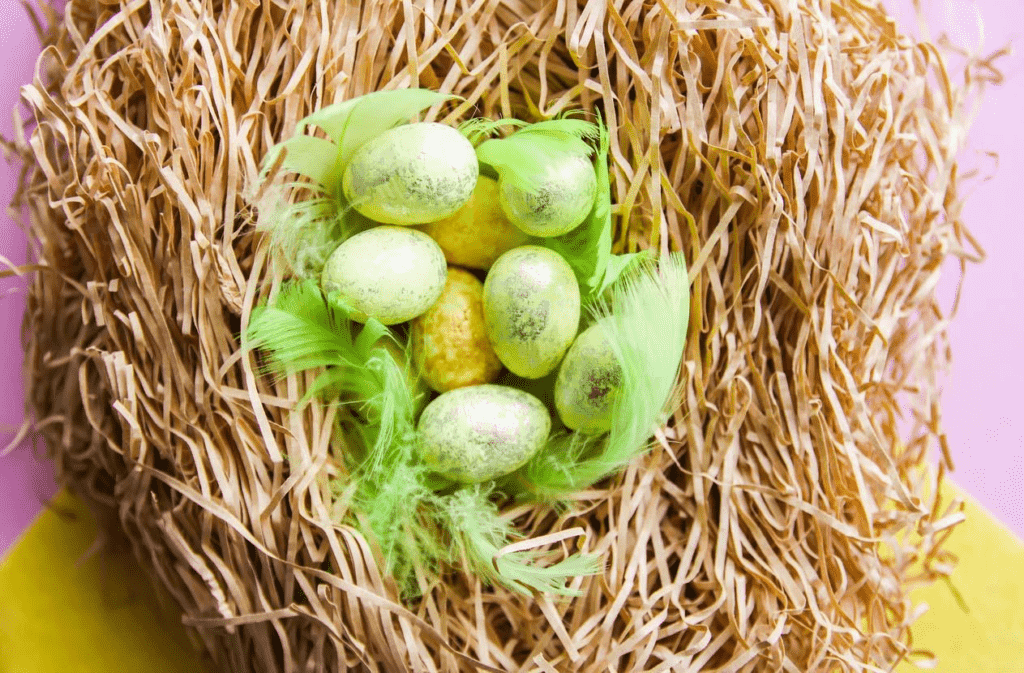
Just like all the other birds, female parakeets lay eggs. So immediately after mating, you should expect your pet to start laying eggs. The mating season for parakeets is usually in spring. Remember, they can lay eggs without a male in the cage to fertilize them. When your bird starts laying eggs, then it’s a female.
But the absence of egg-laying doesn’t make the pet a male. It may have just not reached the right age. There are several other reasons why your pet won’t lay eggs.
It may be too old or young. It may also be malnutrition or uterine egg-binding disorders. So if you’re not sure, then you should try endoscopic tests.
Step 6: Monitor The Noises Produced
A parakeet is a loud parrot species. They talk, mimic voices, and often sing when they’re happy. But when you place them in the same cage, you’ll notice that the males produce more noise than the females.
Male parakeets tend to sing or chirp more than females. The females make noises but tend to be less musical and angry. So you should focus on the type of noise produced. For instance, during the courting sessions, the birds make chattering noises. They’re also known for chattering at their reflection.
Step 7: Examine Their Behavior
Generally, parakeets communicate with their owners or other pets in many ways. You may be confused if it’s your first Parakeet; luckily, reading their body language is easy. Remember, correctly reading it can help you take good care of it. Fortunately, females and males have some unique behaviors.
For instance, males tap their beaks on the cage or bob it up and down. The picture of them bobbing their heads makes it seem playful. When in the mood to mate or are fertile, the females tend to be quite aggressive.
If one of the parakeets regurgitates its food and tries to feed the other one, then the one receiving the food is a female. This unique bonding behavior always preludes mating. Another familiar mating ritual is the males singing to their mates.
Step 8: Ask For Help
If you are still not sure of the Parakeet’s gender, even after trying the above methods, then you should ask a professional for help. A vet can help you determine the sex of the parrot by doing several tests. You can even ask the breeder to tell you the sex of the parrot even after adopting one. After all, they keep a record of all the parakeets they breed.
Conclusion
Parakeets make exceptional pets that can beautify your life for over two decades. But the first step to guaranteeing that your pet will even outlive you is determining its sex and then planning its diet, cage, and even the lifestyle you want to give it.
If you plan on breeding parakeets, you must get a pair. Or if you already have a male and are looking for a female, then knowing the sex of your pet is mandatory.
Some popular methods include DNA sexing, including testing the blood, feather, or eggshells. The best option for chicks is eggshells. The other popular option that can even help you confirm if your pet has any further complications is the endoscopic sexing test.
But if you dislike the invasive methods, then you can try visual sexing, which includes examining the colors of the cere and feet. If it lays eggs, then it’s a female. On the other hand, its behavior can also help you determine its sex.
- Wikipedia contributor, Parakeet,https://en.wikipedia.org/wiki/Parakeet/ Accessed April 18, 2023
- Sha Jiang et al., Effects of Dietary Energy and Calcium Levels on Performance, Egg Shell Quality and Bone Metabolism, in Hen,https://pubmed.ncbi.nlm.nih.gov/24054908/ Accessed April 18, 2023
- R Griffiths et al., A DNA test to sex most birds,https://pubmed.ncbi.nlm.nih.gov/9711866/ Accessed April 18, 2023
- YouTube contributor, How I DNA my Birds- Avian DNA Sex,https://www.youtube.com/watch?v=iwL8dxoQ-Ck/ Accessed April 18, 2023
- Wikipedia contributors, Endoscope,https://en.wikipedia.org/wiki/Endoscope/ Accessed April 18, 2023
- YouTube contributors, Male Vs. Female budgies genders by the cere (Simple and easy guide),https://www.youtube.com/watch?time_continue=209&v=5nq8_3hMK60&embeds_euri=https%3A%2F%2Fwww.google.com%2F&source_ve_path=MzY4NDIsMjg2NjY&feature=emb_logo/ Accessed April 18, 2023
- Color of Parakeet cere,https://www.google.co.ke/books/edition/Parakeets_And_Budgies_Raising_Feeding_An/-fL5BQAAQBAJ?hl=en&gbpv=1&dq=color+of+parakeet+cere&pg=PT107&printsec=frontcover/ Accessed April 18, 2023



